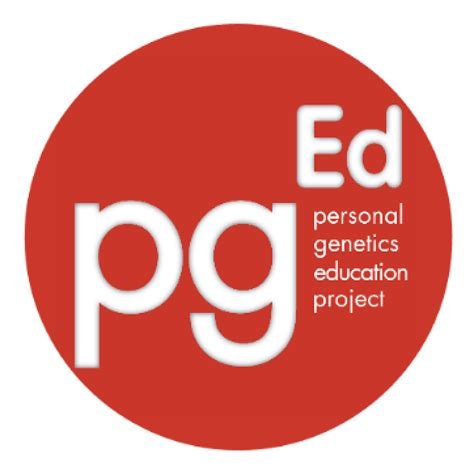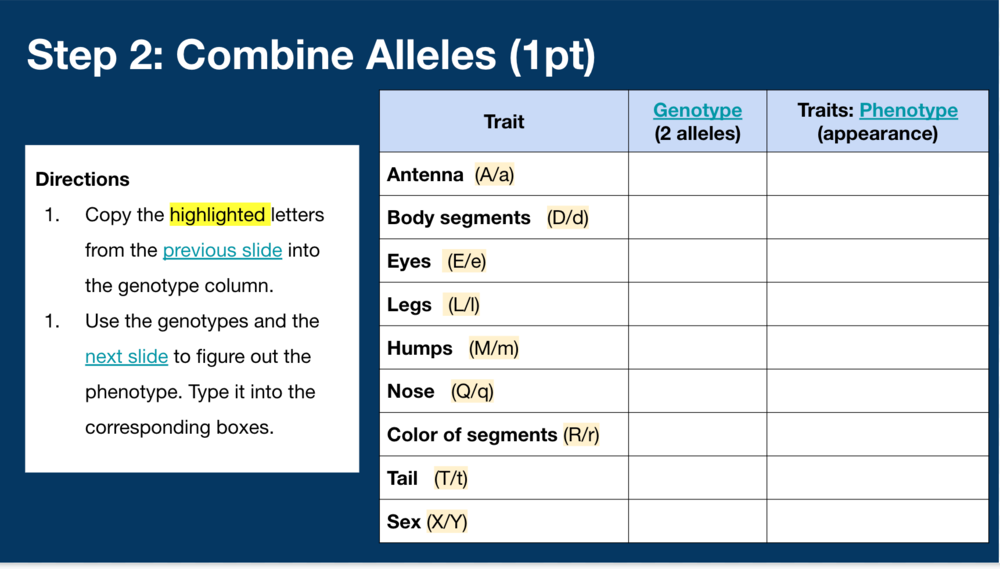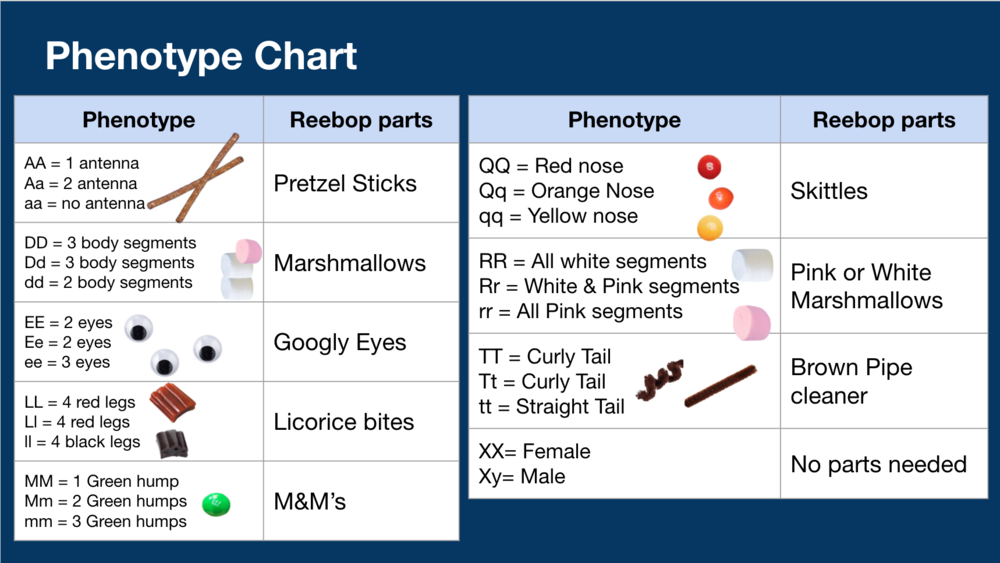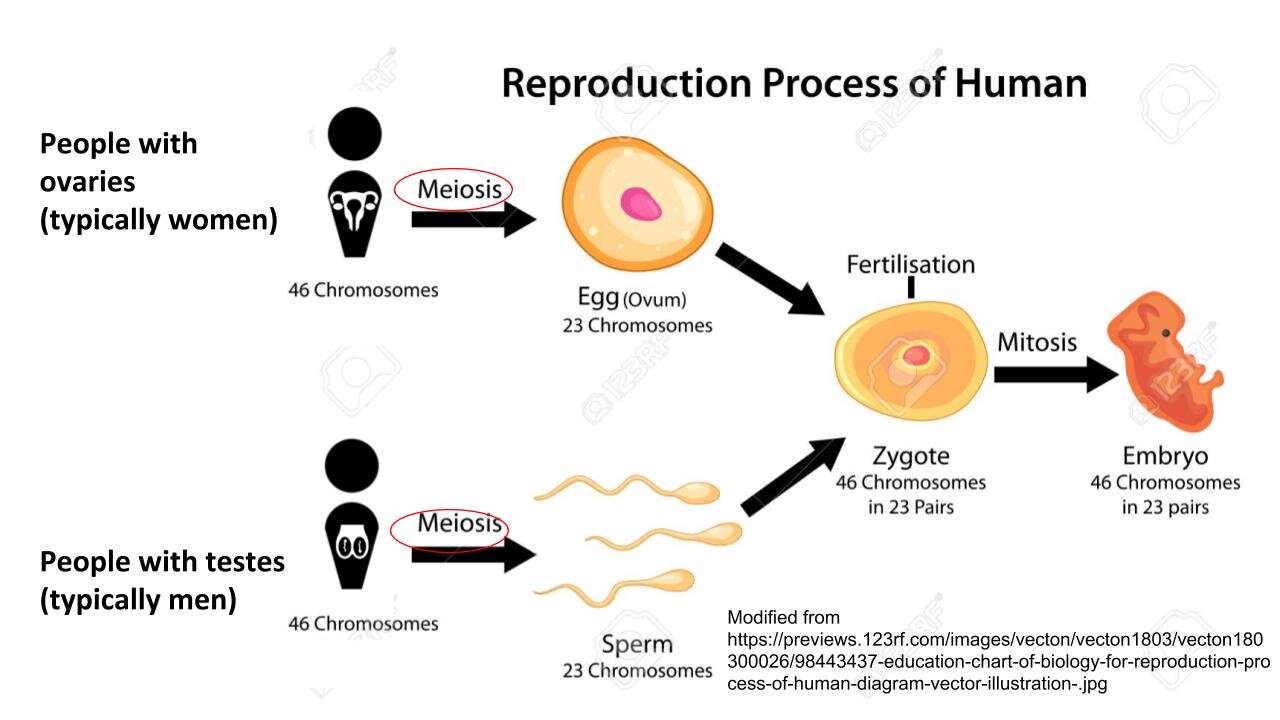Radiolab Presents: Gonads is a multi-episode journey deep into the parts of us that let us make more of us. Longtime staff producer and host Molly Webster explores the primordial roots of our drive to reproduce, introduces a revolutionary fertility procedure that sounds like science fiction, reveals a profound secret about gender that lives inside all of us, and calls on writers, educators, musicians, artists and comedians to debate how we’re supposed to talk to kids about sex.
Interactive: Meiosis in Animal Cells
This interactive from LabXchange has students scroll, click, and learn about meiosis in the context of reproduction. It uses language that is precise and inclusive of diverse human families, while also teaching the concept broadly enough to apply to other living things.
Pedigree Webinar from PGED
In this webinar video, an expert panel discusses how to represent wide-ranging family structures and personal identities using the latest pedigree nomenclature
Personal Genetics Education & Dialogue (PGED) raises awareness about genetics and discuss how genetic technologies impact people’s lives now and in the future.
Reebops Nursery (gender-inclusive Genetics of independent assortment)
Gender-inclusive simulation of independent assortment for a genetics or evolution lesson. Adapted from slides created by Laura Funk (staff profile page) by modifying “mom” to egg-giver and “dad” to sperm-giver. Can also serve as model for discussion about mutations, epigenetics, evolution, chromosomes, alleles, nondisjunction. See also Teach.Genetics.Utah.edu's paper-based activities. See steps below and the questions for the assessment at the end. (Originally published here in 3/17/21.)
NGSS Works towards HS-LS3-1. Follow up with meiosis and HS-LS3-2.
Step 1: Flip a coin and highlight the capital or lowercase letter for that row.
Step 2: Combine the results from Step 1 to create a genotype (two letters).
Step 3: Use the third slide to decode the phenotype.
Step 4: Build the reebop based on the phenotype.
Assessment: Answer the questions in the Google Form.
0. Attach completed Reebops Nursery from your Drive.
1. Name your Reebop
2. What do you think each letter represents in the model?
3. What do you think combining the letters represents in the model?
4. All models are wrong. Some models are useful. What are some things missing from this model? List as many as you can think of.
5. Gametes (egg & sperm cells) contain 1 pair of chromosomes (n = haploid), the other body cells contain 2 pairs of chromosomes (2n=diploid). Is your baby reebop haploid or diploid?
California Condors reproduce without a male. A first.
Erik Anderson reports for KPBS the discovery that captive condors have reproduced through parthenogenesis, with just a single parent and an unfertilized egg.
The macho sperm myth: Article by Robert D. Martin
Image source: LetsTalkSex.net
“Human fertilisation is a gigantic lottery with 250 million tickets: for healthy sperm, it is the luck of the draw.”
In this popular science article, Martin debunks a series of myths and double standards in human reproduction, including the pervasive, heteronormative belief that sperm cells "race" to reach an egg.
Many asexually-reproducing Unisexual (all-lesbian) anole lizard species frequently copulate anyway. (Gender Showcase, 9-12)
Though they can reproduce without a partner, these progesterone cycling lizards frequently court and copulate with one another.
Pictured: Aspidoscelis tesselata by Vicente Mata-Silva
Confused?
If the entire species is one sex, how can there be lesbian? Doesn’t there have to be something else? Here, “lesbian” is used to refer to how their behavior is based on progesterone cycles but the entire species is one sex; if it were based on testosterone cycles, I assume authors would have referred to it as gay asexual lizards.
If they’re asexual, why are they having sex? Here, “asexual” means they’re able to reproduce without having sex. Some humans identify as asexual, but this is different from the term “asexual reproduction” as it is traditionally used in biology.
Some parthenogenic unisexual species include:
Cnemidophorus inornatus (Arizona whiptail lizard)
Cnemidophorus velox (Colorado whiptail lizard)
Cnemidophorus tesselatus (Colorado whiptail lizard)
Aspidoscelis tesselatus (Common checkered whiptail lizard)
Book Excerpt
Courtship in an asexual species is almost exactly the same [as in sexual species of American whiptail lizards].(EN3) One of the females copies the male role down to the last detail. One mounting female was even seen everting her cloacal region to contact the cloacal area of the mounted female. Courtship between female whiptail lizards is not a sloppy parody of male-female courtship left over from its sexual ancestry, but an intricate and finely honed sexual ritual.
When two females are housed together, they quickly wind up with alternating hormonal cycles. (EN4) As one female cycles into high estradiol, her eggs mature and she assumes the female role in courtship. At the same time, the other cycles into high progesterone (not testosterone) and assumes the male role. Then they switch roles a few weeks later as their hormone cycles switch. (Roughgarden 129)
Why do asexual females bother with courtship?
Because they lay twice the number of eggs!
In nature, asexual females lay an average of 2.3 batches of eggs each season. If a female is housed alone, she lays only about 0.9 batches. If housed with a female whose hormonal state leads to male behavior, she lays 2.6 batches during the season. (Roughgarden 130)
New Mexico’s Environthon reports:
“The New Mexico Whiptail, as well as several other all-female species of whiptail lizard, does reproduce, and all of its offspring are female. Moreover, it reproduces by parthenogenesis -- its eggs require no fertilization, and its offspring are exact and complete genetic duplicates of the mother. Scientists understand only partially how this reproductive mode developed, and it raises many questions. One of the most intriguing is how this cloning affects the lizard's ability to adapt to environmental changes. Since there is no genetic variation except that which occurs through mutation, the New Mexico Whiptail cannot evolve as other species do.”
National Geographic Magazine (Nov 2016 issue) reports on the Baumann team’s research:
“The lizards are all female and parthenogenetic, meaning their eggs develop into embryos without fertilization. But before the eggs form, Baumann’s team discovered, the females’ cells gain twice the usual number of chromosomes—so the eggs get a full chromosome count and genetic variety and breadth (known as heterozygosity) rivaling that of a sexually reproducing lizard.
Why does this occur?
Because long ago, Baumann says, lizards of the genus Aspidoscelis had “a hybridization event”—that is, females of one species broke form and mated with males of another species. Those outlier liaisons gave whiptails robust heterozygosity, which has been preserved by the identical replication—essentially, cloning—that occurs in asexual reproduction. It’s a genetic-diversity advantage that today’s females still enjoy and propagate.”
Crews, D. (1987) Courtship in Unisexual Lizards: A Model for Brain Evolution. Scientific American Vol. 257, No. 6 (December 1987), pp. 116-121. writes:
“The females produce by parthenogenesis, that is, reproduction without fertilization, and therefore copulation between its members is not directly related to the production of offspring. Nevertheless, the females in this species actively engage in courtship rituals that are virtually identical with those observed between male and female whiptail lizards.”
Book Citations: Roughgarden, J. (2013) Evolution’s Rainbow: Diversity, Gender, and Sexuality in Nature and People. University of California Press, Berkeley. pp. 129-131.
Related Citations
D. Crews and K. Fitzgerald, 1980, "Sexual" behavior in parthenogenetic lizards (Cnemidophorus), Proc. Nat. Acad. Sci. (USA) 77:499-502
D. Crews, 1987, Courtship in unisexual lizards: A model for brain evolution, Scientific American 257 (6): 116-21.
L. Young and D. Crews, 1995, Comparative neuroendocrinology of steroid gene expression and regulation: Relationship to physiology and behavior, Trends in Endocrinology and Metabolism 6: 317-23.
D. Crews, M. Grassman, and J. Lindzey, 1986, Behavioral facilitation of reproduction in sexual and unisexual whiptail lizards, Proc. Nat. Acad. Sci. (USA) 83:9547-50.
C. Cole and C. Townsend, 1983, Sexual behaviour in unisexual lizards, Anim. Behav. 31:724-28.
D. Crews and L. Young, 1991, Pseudocopulation in nature in a unisexual whiptail lizard, Anim. Behav. 42:512-14.
B. Leuck, 1982, Comparative burrow use and activity patterns of parthenogenetic and bisexual whiptail lizards (Cnemidophorus: Teiidae), Copeia 416-25.
B. Leuck, 1985, Comparative social behavior of bisexual and unisexual whiptail lizards (Cnemidophorus), J. Herpetology 19:492-506.
Y. Werner, 1980, Apparent homosexual behavior in an all-female population of a lizard, Lepidodactylus lugubris, and its probable interpretation, Tierpsychol. 52:144-50.
M.J. McCoid and R.A. Hensley, 1991, Pseudocopulation in Lepidodactylus lugubris, Herpetological Review 22:8-9.
Dias, B. G., & Crews, D. (2006). Serotonergic modulation of male-like pseudocopulatory behavior in the parthenogenetic whiptail lizard, Cnemidophorus uniparens. Hormones and behavior, 50(3), 401–409. https://doi.org/10.1016/j.yhbeh.2006.05.001
Paulissen, M., & Walker, J. (1989). Pseudocopulation in the Parthenogenetic Whiptail Lizard Cnemidophorus laredoensis (Teiidae). The Southwestern Naturalist, 34(2), 296-298. doi:10.2307/3671747
“What Makes a Baby”: 8th grade edition!
In this blog post, Gender Inclusive Biology contributor Lewis-Maday Travis discusses how he adapted a gender-inclusive reproduction picture book for his 8th grade students. He also discusses student-created language to describe a person who contributes an egg or a sperm to create a new human.
Lesson Plan: Animal Patterns of Reproduction
Image shows nine animals species that exhibit sexual dimorphism or unique reproductive strategies: elephant seals, seahorses, mallad ducks, Indian peafowl, Mormon cricket, honey bee, magnificent riflebird, clownfish, and slipper limpet.
In this lesson, students learn briefly about the reproductive strategies nine different animal species. Student use a tally to track what strategies are most common - for example, male competition, female mate choice. More unique patterns like sex-changing clownfish and touch-mediated sex development are included within the nine species.
When I taught this lesson, students learned about each species through short video recordings of teachers in our school describing the species. For more general use, I changed the lesson as posted on this website to have students do online research instead of watching the videos.
Diagram of Human Reproductive Process
Early in my teaching career I modified an existing diagram to create this image which shows how meiosis in testes and ovaries functions to complete the human life cycle. I could not in good conscience use existing diagrams where the two rows were labeled “Mother” and “Father”, “Woman” and “Man”, in text colored pink and blue, etc.. I needed something that precisely communicated the structures and processes involved, in a way that was simple for my students. Reflecting back, the phrases in parentheses may or may not be necessary depending on the audience. - Sam
Diagrams: Animal Lives Gallery by Humon
Image shows two purple-colored figures with male symbols and one orange-colored figure with a female symbol, all caring for two yellow-colored babies.
This gallery of art by Humon depicts diverse animal mating behavior in 20 different species.
The Egg and the Sperm: How Science Has Constructed a Romance Based on Stereotypical Male-Female Roles
The false romance of egg and sperm
In this article, anthropologist Emily Martin analyzes the metaphors that are used to teach reproduction and makes the claim that these metaphors reflect the socially constructed definitions of male and female.
Martin highlights modern research that dispels stereotypes of the sperm as being more aggressive, remarkable, and valuable than the egg. She advises scientists and educators to be aware of biases in the metaphors we use to describe human sex cells.
















